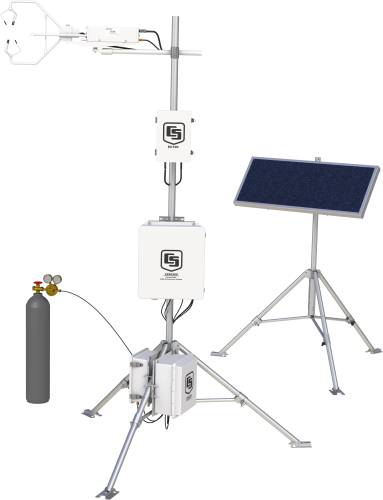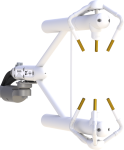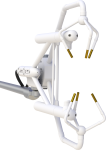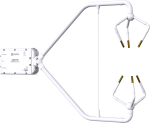This product is not available for new orders. We recommend ordering: CPEC310.

| Services Available | |
|---|---|
| Repair | Yes |
| Calibration | Yes |
| Free Support | Yes |
概览
CPEC200为闭路式涡度相关系统,用于测量 下垫面-大气 界面上的CO2、水汽、热及动量的交换。系统中包括Campbell Scientific的EC155闭路式气体分析仪、CSAT3A三维超声风速仪、CR3000数据采集器,还有其它的硬件和软件,构成了功能齐全的涡度相关系统。
优势与特点
- 配有全部管路的完全集成的系统
- 低功耗操作
- 优异的频率响应性能
- 可选的自动调零和跨度校准
图像



技术说明
EC155的气体测量腔室的容积很小(5.9 ml),最小化了气样的驻留时间(在7 LPM的名义系统流速下,约 50 ms)。在低系统功耗(12 W)的同时,提供了优异的频率响应性能(5.8 Hz的半功率谱波宽)。
涡度相关测量
CO2 和 H2O 由EC155闭路气体分析仪测量,三维风速和声温由CSAT3A超声探头测量。
CPEC200系统机箱
一个 16英寸x18英寸 的玻璃纤维耐候机箱,用于安装数据采集、可选的存储外设、可选的气阀模块、以及与闭路气泵模块相连的电子接口。系统机箱可以被固定到主桅杆上、CM106的斜腿上、直立塔的立柱上或大直径的立杆上。
CPEC200的气泵模块
气泵模块是CPEC200闭路系统的标准部件,包含一个带无刷直流电机的小的双头隔膜泵,固定在玻璃纤维机箱的内部;一条集成的电缆连接气泵模块与系统机箱,提供供电、温度测量与控制、压力测量以及气泵流速测量与控制。
气阀模块(可选)
Campbell Scientific提供两种气阀模块。基本的3阀模块(货号: 27559)让CPEC200系统具有自动实施零点校准、CO2跨度校准和H2O跨度校准的功能。而6阀系统(货号:26578)具有更多的三个气阀,可以接入更多的CO2跨度气瓶。气阀模块位于CPEC200系统机箱内,分支管的出口具有一个比例阀用于自动控制切换 零点/跨度 气体。
产品规格
| 操作温度范围 | -30° to +50°C |
| Input Voltage Range | 10.5 to 16.0 Vdc |
| Power |
|
System Enclosure |
|
| Dimensions | 52.1 x 44.5 x 29.7 cm (20.5 x 17.5 x 11.7 in.) |
| Weight |
|
Pump Module |
|
| Inlet Connection | 3/8-in. Swagelok |
| Pumping Speed | 3 to 9 LPM (automatically controlled at the setpoint, typically 7 LPM) |
| Pressure Sensor Range | 15 to 115 kPa |
| Cable Length | 3.0 m (10 ft) |
| Dimensions | 35.6 x 29.2 x 13.5 cm (14.0 x 11.5 x 5.3 in.) |
| Weight | 5.4 kg (11.8 lb) without mounting bracket |
Valve Module |
|
| Inlets for Three-Valve Module | Zero, CO2, span, and H2O span |
| Inlets for Six-Valve Module | Zero, CO2 span 1 to CO2 span 4, and H2O span |
| Outlets | Analyzer and H2O bypass |
| Connections | 1/4-in. Swagelok |
| Dimensions | 14.0 x 12.7 x 14.0 cm (5.5 x 5.0 x 5.5 in.) |
| Weight of Three-Valve Module | 1.5 kg (3.3 lb) |
| Weight of Six-Valve Module | 1.9 kg (4.2 lb) |
Scrub Module |
|
| Power |
|
| Cylinder Volume | 480 cm3 each (29.29 in.3) |
| Molecular Sieve Size | 1.6 to 2.5 mm beads |
| Enclosure Dimensions | 39.4 x 34.3 x 20.3 cm (15.5 x 13.5 x 8.0 in.) |
| Weight | 9.6 kg (21.1 lb) |
相关技术文档
说明书
下载
CR3000 OS v.32.07 (4.39 MB) 15-05-2024
Execution of this download installs the CR3000 Operating System and Compiler on your computer. It also updates the CR3000 support files for the CRBasic Editor.
Note: The Device Configuration Utility is used to upload the included operating system to the datalogger.
Upgrading from versions prior to version 28 of the Operating System will reset the datalogger’s CPU drive. This is due to a change in the format of the file system from FAT16 to FAT32. In order for the datalogger to operate correctly, as part of the upgrade, the CPU drive is formatted to FAT32. Any programs stored and running from the CPU drive will be lost. It is not recommended to update the datalogger’s Operating System over a remote connection where program control regulates the communication equipment (turning it on or off, etc.). In these cases, an on-site visit and a backup using DevConfig’s backup utility is necessary to update the datalogger’s Operating System.
Watch the Video Tutorial: Sending an OS to a Local Datalogger.
In all cases where the datalogger is being updated from an Operating System prior to 28, the use of DevConfig’s backup utility is recommended due to the CPU drive being formatted using the new FAT32 format.
CPEC200 CR3000 Program () 01-09-2011
Micrometeorology Group (435) 227-9100.
Device Configuration Utility v.2.33 (49.6 MB) 07-07-2025
A software utility used to download operating systems and set up Campbell Scientific hardware. Also will update PakBus Graph and the Network Planner if they have been installed previously by another Campbell Scientific software package.
Supported Operating Systems:
Windows 11 or 10 (Both 32 and 64 bit)
EC100 OS v.8.02 (560 KB) 14-10-2019
EC100 Operating System.
Watch the Video Tutorial: Updating the EC100 Operating System.
ECMon v.1.6 (10.7 MB) 29-03-2016
EC100-Series Support Software.
CSAT3H Heater Controller v.14.2 (46 KB) 02-02-2021
The CSAT3H Heater Controller ships with this encrypted program. This program is for the unlikely event that the program needs to be re-installed or updated to a newer version. Please contact Campbell Scientific if you have questions about the program or would like the algorithm modified for a specific application.
常见问题解答
CPEC200: 13
展开全部收起全部
-
The pump module fan continues to draw 0.7 W while operational.
-
The heater for the CPEC200 is not positioned along the intake pipe. The heater is in the "snout/rain-cap" of the vortex intake.
-
-
The pump has a one-year warranty. Although the pump’s manufacturer does not specify an expected lifetime, the pump’s lifetime is expected to be significantly longer than one year.
-
Yes. The 28549 comes with a field wireable plug (pn 28771) to make it easy to use an extension cord. Purchase an extension cord that is rated for outdoor use, and have a qualified electrician replace the female connector on the extension cord with the field wireable plug. This will avoid the issue of a power cord junction exposed to the environment.
-
If the pump fails, it must be replaced. Contact Campbell Scientific for details. For the process of returning equipment to Campbell Scientific, refer to the Repair and Calibration page.
-
Campbell Scientific recommends Synflex 1300 (pn 15702, Raw Plastic Tubing .250 in. OD). This tubing has a durable polyethylene jacket and an aluminum wrap to limit diffusion through the wall. The aluminum layer also makes this tubing easier to work with, as it does not tend to spring back into a coiled shape as much as other tubing types.
-
Yes, the heater is controlled the same way. Campbell Scientific recommends leaving the heater on all the time.
-
Make sure the fitting is a ¼ in. Swagelok. It is possible that it is 6 mm instead. Metric fittings can be identified by the groove on the hex body of the fitting. If the fitting is 6 mm, replace the fitting on the regulator with a ¼ in. Swagelok, or use an adapter fitting.
-
Yes, the pump works a little harder with the new vortex. The recommended flow for the new vortex system is 8 LPM (6 to sample cell + 2 to bypass). 7 LPM was recommended for the original system. Also, the sample cell “differential” pressure is slightly lower (~-6kPa_new versus ~-3kPa_original). It’s a balance of parameters to maintain good frequency response, low power, and low maintenance.
案例研究
Forest habitats contribute more than any other terrestrial biome to carbon cycles and processes. It......阅读更多





